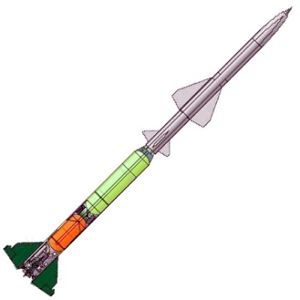
Home - Search - Browse - Alphabetic Index: 0- 1- 2- 3- 4- 5- 6- 7- 8- 9
A- B- C- D- E- F- G- H- I- J- K- L- M- N- O- P- Q- R- S- T- U- V- W- X- Y- Z
EKR
 EKR Cutaway |
Status: Study 1953. Payload: 200 kg (440 lb). Thrust: 93.00 kN (20,907 lbf). Gross mass: 7,874 kg (17,359 lb). Height: 21.00 m (68.00 ft). Diameter: 0.88 m (2.88 ft).
Further, Korolev had to place the highest priority on development of the R-7 ICBM. Therefore a final government decree on 20 May 1954 authorized the Lavochkin and Myasishchev aircraft design bureaus to proceed in parallel with full-scale development of trisonic intercontinental cruise missiles. The Eksperimentalniy krilatiy raket (experimental winged rocket) as designed by Korolev would have been a Mach 3 ramjet, accelerated to supersonic cruise speed by an R-11 booster. Smaller than the operational vehicle proposed by the Germans, it would have a range of 730 km with flight time of 927 seconds, a lift to drag ratio of 2.51, and a wing area 3.31 square meters.
Maximum range: 730 km (450 mi).
Stage Data - EKR
- Stage 1. 1 x EKR Stage 1. Gross Mass: 6,390 kg (14,080 lb). Empty Mass: 1,564 kg (3,448 lb). Thrust (vac): 107.333 kN (24,129 lbf). Isp: 250 sec. Burn time: 127 sec. Isp(sl): 217 sec. Diameter: 0.88 m (2.88 ft). Span: 3.06 m (10.05 ft). Length: 8.29 m (27.19 ft). Propellants: Lox/Kerosene. No Engines: 1. Engine: S2.253 derivative. Status: Study 1953. Comments: First stage for Eksperimentalnaya krilataya raketa (experimental winged rocket), Mach 3 ramjet. Boosted second stage to ramjet ignition conditions.
- Stage 2. 1 x EKR Stage 2. Gross Mass: 1,484 kg (3,271 lb). Empty Mass: 1,167 kg (2,572 lb). Thrust (vac): 6.129 kN (1,378 lbf). Isp: 1,580 sec. Burn time: 800 sec. Diameter: 0.65 m (2.13 ft). Span: 2.02 m (6.62 ft). Length: 9.43 m (30.95 ft). Propellants: Air/Kerosene. No Engines: 1. Engine: EKR Ramjet. Status: Study 1953. Comments: Second stage for Eksperimentalnaya krilataya raketa (experimental winged rocket), Mach 3 ramjet. Range 730 km with flight time of 927 seconds. Lift to drag 2.51, wing area 3.31 square meters. Not developed but formed basis for Burya and Buran missiles.
Family: IRCM. Country: Russia. Engines: S2.253 derivative, EKR Ramjet. Stages: EKR Stage 2, EKR Stage 1. Agency: Korolev bureau. Bibliography: 283, 89.
 | EKR ramjet 2 view Credit: © Mark Wade |
 | EKR ramjet 160 pixel Credit: © Mark Wade |
1953 January - . LV Family: R-12. Launch Vehicle: EKR.
- Expert commission examined the EKR design - .
Nation: Russia.
Related Persons: Korolev,
Lavochkin,
Myasishchev.
Program: Navaho.
Spacecraft Bus: Buran M.
Spacecraft: Buran M-42.
In 1951 to 1953 Korolev's design bureau had prepared an experimental trisonic ramjet design, the EKR.The expert commission ifelt that there were still many technical problems to be solved, most of which were better handled by an aircraft designer rather than Korolev. Further, Korolev had to place the highest priority on development of the R-7 ICBM. Therefore a final government decree on 20 May 1954 authorised the Lavochkin and Myasishchev aircraft design bureaux to proceed in parallel with full-scale development of trisonic intercontinental cruise missiles.
1953 February 13 - . LV Family: R-12. Launch Vehicle: EKR.
- Authorisation for development of Soviet intermediate and intercontinental range missiles. - .
Nation: Russia.
Council of Soviet Ministers (SM) Decree 'On approval of work on themes T1 and T2, on approval of work on the R-5, R-11, and EKR missiles, and on transferring draft project work for the R-12 from NII-88 to SKB-586' was issued. The decree set forth three phases of state trials tests for the R-5 missile.
Back to top of page
Home - Search - Browse - Alphabetic Index: 0- 1- 2- 3- 4- 5- 6- 7- 8- 9
A- B- C- D- E- F- G- H- I- J- K- L- M- N- O- P- Q- R- S- T- U- V- W- X- Y- Z
© 1997-2019 Mark Wade - Contact
© / Conditions for Use